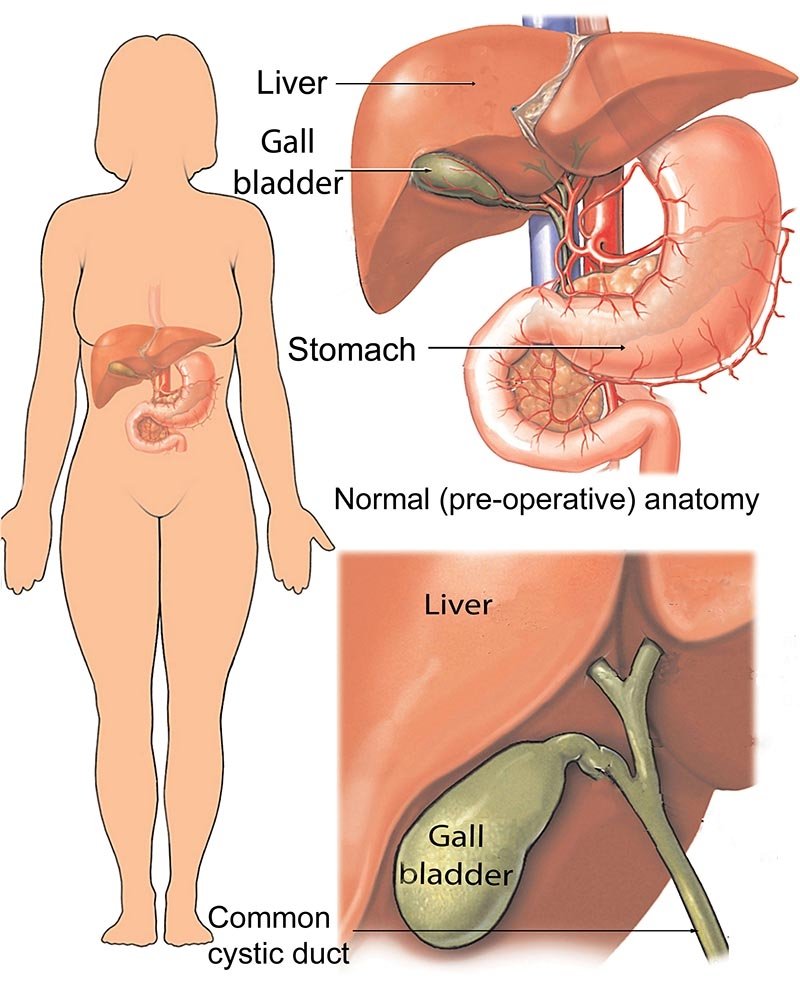
GALL BLADDER
The gallbladder is a small organ located under the liver that helps with digestion by storing bile, a digestive fluid produced by the liver. Gallbladder problems can arise when there is an issue with the normal functioning of the organ.
Some Common Gallbladder Problems Include:
Gallstones: These are hard deposits that form in the gallbladder, often made up of cholesterol or bilirubin. Gallstones can cause pain in the upper right abdomen, nausea, and vomiting.
Cholecystitis: This is inflammation of the gallbladder, often caused by gallstones blocking the ducts leading to the organ. Symptoms include pain, fever, and nausea.
Biliary Dyskinesia: This is a condition where the gallbladder doesn’t empty properly, leading to pain and discomfort in the upper right abdomen.
Gallbladder Cancer: Although rare, gallbladder cancer can develop in the organ.
Symptoms of Gall Bladder Stones
The symptoms of gallbladder stones, also known as gallstones, can vary from person to person, and some people may not experience any symptoms at all. However, some common symptoms of gallstones include:
- Abdominal Pain
- Nausea and Vomiting
- Jaundice
- Clay-Colored Stools
- Indigestion
- Shoulder or Back Pain
Diagnosis of Gall Bladder Stones
To diagnose gallbladder stones, also known as gallstones, your doctor will perform a physical exam and order some diagnostic tests. These tests may include:
- Ultrasound: This imaging test uses sound waves to create an image of your gallbladder, and can detect the presence of gallstones.
- CT scan: A computed tomography (CT) scan is an imaging test that uses X-rays to create detailed images of the inside of your body, including your gallbladder.
- Blood Tests: Blood tests can be used to check for signs of infection or inflammation in the body.
- MRCP Scan: This test uses a special magnetic waves to create images of the gallbladder and bile ducts,
- Endoscopic Retrograde Cholangiopancreatography (ERCP): This test uses an endoscope, a flexible tube with a camera, to examine the bile
- ducts and pancreas
It’s important to seek medical attention if you experience symptoms such as severe abdominal pain, especially if it’s accompanied by fever, jaundice, vomiting, or other concerning symptoms. If you’re diagnosed with gallstones, the surgeon can recommend appropriate treatments to prevent or manage these complications.
Treatment Options For Stones
The treatment of gallstones, depends on the severity of the symptoms and the overall health of the patient. Some treatment options include:
- Observation: If the gallstones are small and not causing any symptoms, your doctor may recommend observation and monitoring of the condition.
- Medications: Certain medications, such as ursodeoxycholic acid, can be used to dissolve small gallstones.
- Surgery: The most common treatment for gallstones is surgery to remove the gallbladder, a procedure called cholecystectomy. This is usually done laparoscopically, which is less invasive and has a shorter recovery time.
- Dietary Changes: Eating a low-fat diet and avoiding foods that can trigger gallbladder attacks may help manage symptoms.
Types of Surgeries
There are two main types of gallbladder surgery for the treatment of gallstones:
- Laparoscopic Cholecystectomy: This is the most common type of surgery for gallbladder removal. It is minimally invasive and involves making small incisions in the abdomen to insert a laparoscope, which is a thin tube with a camera attached. The surgeon uses the camera to view the inside of the abdomen and remove the gallbladder with specialized surgical instruments. This procedure is usually done as an outpatient surgery and has a shorter recovery time compared to traditional open surgery.
- Open Cholecystectomy: This procedure involves making a larger incision in the abdomen to remove the gallbladder. Open surgery is usually performed when the patient has complications, such as severe inflammation or scarring, or when laparoscopic surgery is not possible. Recovery time for open surgery is longer than laparoscopic surgery, and the patient may need to stay in the hospital for a few days.
In both types of surgery, the gallbladder is removed completely, which means there is no chance of the gallstones recurring. Your doctor will recommend the best type of surgery for your individual case based on your medical history and the severity of your symptoms.
Recovery After Gall Bladder Surgery
Recovery after gallbladder surgery, also known as cholecystectomy, varies depending on the type of surgery performed, the patient’s age and overall health, and the presence of any complications. Here are some general guidelines for recovery after gallbladder surgery:
- Hospital Stay: Most patients are discharged the same day or the day after laparoscopic cholecystectomy. For open cholecystectomy, patients may need to stay in the hospital for several days.
- Pain Management: Pain after surgery is normal and can be managed with medication prescribed by your doctor.
- Activity: Most patients can resume normal activities, including driving, within a week or two after laparoscopic cholecystectomy. For open cholecystectomy, it may take longer to resume normal activities.
- Diet: Initially, you may be placed on a clear liquid diet and slowly advance to solid foods as tolerated. Your doctor may recommend a low-fat diet to help prevent digestive issues.
- Incision Care: Follow your doctor’s instructions for caring for your incision, including keeping the incision clean and dry.
- Follow-up Appointments: You will need to follow up with your surgeon for a postoperative check-up to ensure proper healing.
If you experience any unusual symptoms, such as fever, severe pain, or redness and swelling around the incision site, contact your doctor immediately.
Have Questions? Get in touch!
Adjoining More Supermarket,
Jalandhar 144022

